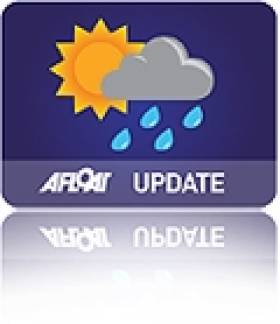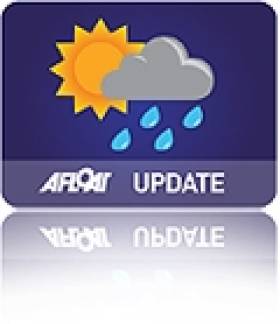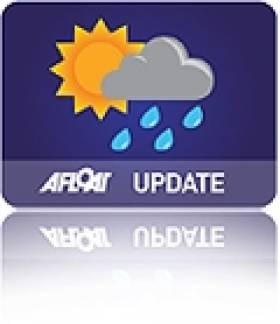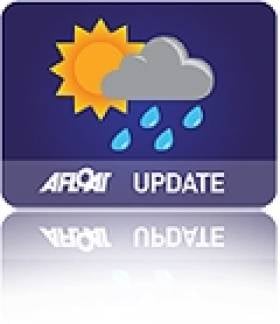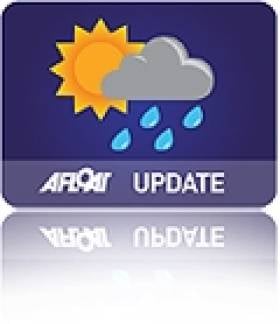Displaying items by tag: Met Eireann
More Winter Floods, Stress On Coastal Habitats: What Climate Change Means For Ireland
#ClimateChange - Models to predict the future climate indicate that global temperatures will rise by an average of as much as 4.5C by the end of this century, bringing a rise in sea levels and changes to rainfall patterns.
And these changes in the weather are already being felt in Ireland, according to Met Éireann's head of climatology Séamus Walsh, who says that even slight shifts, such as an increase in the number of warm days over 20C, have "a knock-on effect on natural ecosystems" that have adapted to Ireland's climate.
"Fragile habitats in vulnerable upland, peatland and coastal areas will come under increasing stress," he adds, noting also a 5% increase in rainfall over the last three decades, more so in the West and North West.
"Climate projections for rainfall have greater uncertainty than for temperature," he explains. "They indicate that overall rainfall amounts in Ireland might decrease slightly, summers are likely to become drier while winters may be wetter, especially in the west and north."
There are also indications of an increase in the number of very wet days – days with rainfall over 20mm – which means that such projections, when applies to river flows, show "an increased risk of winter flooding, an increased risk of short duration ‘flash’ floods and to possible water shortages in summer months due to higher temperatures and lower rainfall.
"The rise in sea levels will make low lying coastal areas more prone to flooding, especially from storm surges," he adds.
Met Éireann has more on the story HERE.
'Status Red' Rain Warning As Storm Desmond Hits Ireland
#Weather - Met Éireann has issued a rare Status Red rainfall warning for western counties as Storm Desmond barrels in from the Atlantic later today (Friday 4 December).
The Irish meteorological service warns of "incessant falls of heavy rain overnight and for all of Saturday" from Kerry to Donegal, with "accumulations in excess of 70mm expected" particularly on higher ground.
Slightly less rain is expected in Cavan, Limerick and Cork but accumulations of up to 70mm are likely, and will result in "flooding and treacherous driving conditions" throughout the western half of the country.
A Status Orange wind warning is in effect for the West Coast, with mean wind speeds of up to 75kmh from the southwest, gusting to 120kmh and strongest in coastal areas.
Met Éireann has declared Status Yellow for wind in Cavan, Monaghan, Roscommon, Leinster and much of Munster with 100kmh gusts expected.
For those at sea, southwesterly gales will develop on all Irish coastal waters and in the Irish Sea as the day progresses, increasing to storm force this afternoon between Loop Head and Fair Head. A Status Yellow small craft warning is in effect.
Waves Setting Records Around Irish Coast
#WaveRecord - The waves just keep getting higher off Ireland's coast!
Following our report in January this year that the M3 weather buoy measured the second highest wave off the West Cork coast comes news of an even bigger swell just a few weeks later.
Met Éireann's Columba Creamer informs us of a maximum individual wave height of 21.91 metres recorded on the night of Monday 23 February.
That's more than two metres clear of the previous record set by the MM3 weather buoy in January 2013, and marks the fourth highest wave recorded across Ireland's buoy network.
But there's more, as Monday 26 January saw Ireland's biggest ever wave – a 23.44-metre whopper – recorded by the M4 buoy off Donegal.
Creamer – Met Éireann's port meteorological officer, who quality controls data streams from Ireland's buoy network – says the four Fugro buoys (labelled M2, M3, M4 and M5) measure significant wave height, individual wave height, swell height, wind wave height, period and direction for each wave type.
Yellow Weather Warning As Remains Of Hurricane Gonzalo Sweep In
#Weather - Met Éireann says a Status Yellow weather warning is in effect for Ireland's coastal waters as the remains of Hurricane Gonzalo are set to sweep over the country from tonight (Monday 20 October).
Mariners are warned to take care as southwesterly gusts and gales are expected to develop this evening, turning northwesterly later tonight and bringing with them heavy rainfall and severe squalls in some areas, particularly in the north and northeast.
Donegal Coast Records Highest Ever Wave as Growlers Reach 80–Feet
#wave – A new maximum wave height measuring nearly 80–feet (23 metres) has been recorded in weekend storms off the coast of Ireland.
Monster waves the height of five double deck buses occurred during last weekend's ferocious storms off the coast of Donegal, the worst for 30 years, according to Donegal news sources.
The M4 weather buoy, located off the Northwest coast, recorded a new maximum individual wave height of 23.4 metres at 15.00 on Sunday 26th January 2014 during the weekend storm that prompted an orange alert by the Coast Guard.
The new wave measurement easily surpasses the previous record of 20.4 metres at the same location in December 2011, according to Met Eireann.
The M4 buoy is one of a new generation of weather buoys with the ability to measure maximum wave height as well as the more usual Significant Wave Height.
The Significant Wave Height is defined as the average height of the highest one-third of the waves and that is what our forecasts of wave height refer to.
In general, the highest wave of all will be about twice the Significant Wave Height.
There was also a record for maximum significant wave height for the M4 buoy of 15.3m at the same time, with the previous record being 14.7m. The all-time record for Significant Wave Height still rests with the M6 buoy of 17.2m.
more from Met Eireann on this story here
Red Alert – Winds to Reach 150km, High Seas Forecast
#storm – Met Eireann have issued a 'status red' weather warning for Western and Northwestern counties, Galway, Mayo, Sligo, Leitrim and Donegal.
Storms will develop later today, with strong south to southwest winds expected over those counties, with damaging gusts of 120 to 150 km/h this afternoon and evening. This will also lead to very high seas.
Met Éireann Launches New iPhone Weather Update App
#Weather - Met Éireann has developed a new smartphone app providing up-to-date weather forecasts for those on the go - especially on the water.
The new app features the latest reports, radar information and satellite imagery with both local and provincial forecasts, with specific forecasts tailored to Ireland's sea area and inland lakes, coastal reports and ferry crossings as well as Atlantic charts.
Users can also adapt the app preferences for their specific location and needs, whether you're aiming to go boating in our inland waterways or go fishing off the coast.
The Met Éireann app is now on iTunes to download for the iPhone, and an Android version is also available.
Live Online Updates From Irish Weather Buoy Network
#MarineInstitute - Keep track on the status of Ireland's coastal waters thanks to the Marine Institute's website, which features live updates from the Irish Marine Weather Buoy Network.
The network is a joint project designed to improve weather forecasts and safety at sea around Ireland. The buoy network provides vital data for weather forecasts, shipping bulletins, gale and swell warnings as well as data for general public information and research.
Data recorded by the six buoys dotted around Ireland's coastal waters, both offshore and far offshore, includes stats on atmospheric pressure, wind speed and direction, wave height and even salinity levels.
The project is the result of successful collaboration between the Marine Institute, the Department of Transport, Met Éireann and the UK Met Office.
Met Éireann Issues 'Yellow' Alert As Strong Gales Sweep Coast
#Weather - Met Éireann has issued a 'yellow' weather alert for coastal areas around Ireland today (4 February) as winds are expected to reach speeds of up to 110km/h.
Westerly winds will continue to reach gale force or strong gale force this evening and tonight on all Irish coastal waters and on the Irish Sea.
Severe gusts of 90 to 110 km/h are predicted for Connacht, Donegal and in coastal areas of Munster. Elsewhere winds will gust between 80 and 90 km/hr.
After dark, showers will become increasingly wintry with the possibility of snow and even blizzard-like conditions, especially in the north and west on high ground.
But meteorologists say that any lying snow will melt during the course of tomorrow morning and afternoon as temperatures rise.
Public Warned To Avoid Coastal Areas As Storm Force Winds Sweep In
#Weather - The Irish Coast Guard has warned the public to stay away from coastal areas today (Friday 28 December) as high winds are expected to reach speeds of as much as 140km per hour in some exposed areas.
It marks the third weather warning for gale force winds this week, as Met Éireann advises of south to south-west winds developing during the day with gusts of 90-100km per hour.
Exposed parts of Connacht and Donegal are set to face the worst of the storm-force winds, with severe gusts of storm force 10 - 100-140km per hour - expected between 6pm and 9pm on the coast from Slyne Head to Erris Head to Malin Head.
Speaking to The Irish Times, meteorologist John Eagleton suggested the possibility of trees coming down and electrical poles falling as the winds strengthen over the course of the day.
"We will get a blast around the evening time," he said, "and I wouldn't like to be sailing a boat along the west coast during those hours."



























